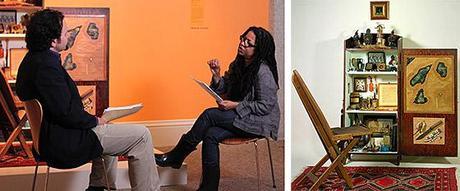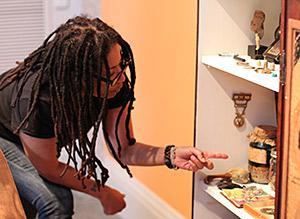
Left: conservator Hugh Shockley talks with artist Renée Stout. Right: Stout's The Colonel's Cabinet
Have you ever looked at a work of art and wished you could ask the artist how they made it? For our conservators, speaking to artists about their works is an important part of their jobs. Conservators want to know exactly what an artwork is made of and how it was constructed before cleaning or treating it. While a variety of high-tech tools can be used to determine the makeup of an artwork, there's nothing better than talking to the person who created it! When readying contemporary artist Renée Stout's mixed media installation The Colonel's Cabinet for display in African American Art: Harlem Renaissance, Civil Rights Era and Beyond, objects conservator Hugh Shockey met with Stout to learn more about the piece. "I specifically wanted to talk to Renée about this work because it's so complex. It's made up of multiple components, many of which she constructed out of different materials, or found and altered in some way," he said. I was lucky enough to be a fly on the wall during their conversation, and I've excerpted some of the discussion below. Read on to learn more about how Renée Stout created this fascinating artwork!
Hugh Shockey: Renée, can you tell me a little bit about the objects in The Colonel's Cabinet?
Renée Stout: I often use both found objects and objects I've constructed specifically to look like they've been found. The objects in this particular piece are used to tell the story of a fictional persona I created, Colonel Frank, and are made to look as though he collected them. He was a traveler, who went out in the world and found these and brought them back to a cabinet of curiosities. He could sit in the chair, which is actually an old ironing board that I reconstructed into a chair, and reminisce about his travels. When I made the map for the cabinet door I was imagining fictitious places and I made up the islands you see on the map, except for the bottom one, which is a map of Africa upside-down. I was creating places where Colonel Frank would have traveled, and some of the objects in the cabinet would have come from those islands. Many of the objects are inspired by what I would have seen in the Carnegie Museum of Natural History when I was a child in Pittsburgh. And they are influenced by my later ideas on spirituality, travel, and identity, and by different cultures from around the world.
HS: I've noticed that you're a master of taking an object and making it look like something else entirely! When dealing with found materials, do you typically modify items to suit a narrative that you already have in mind, or do you leave objects the way you found them and let them inspire a story?

RS: Both, actually. Sometimes I come across an object, in an antique store for example, and all of a sudden I have an idea for a narrative for that piece. Sometimes I have a story I want to tell and will create something or modify an object specifically for it. Other times I'll start making something and the narrative comes as I'm working. For example, on the top shelf, there's a little urn—that's just the way I found it. I didn't alter it in any way. But then there are other objects like the two photographs, the one of the civil war soldier and the one of Frederick Douglass. Those aren't actually old photographs. To create something like those I often use photos from magazine articles, for instance, that I then age, and put into old daguerreotype frames to make them look like old, found photographs.
HS: What would you use to age something like that?
RS: There are a variety of aging processes that I've figured out and that I employ in my work. I'll use tea, coffee, varnish, dirt, maybe watered-down acrylic paint. In some cases, like with the kachina doll on the top shelf, I found a picture of a kachina and then made one that looked just like it, painting it brightly like it would be if you found it when it was new, and then I sanded the surface to make it look old.
HS: So, the distressing and the sense of age is really important in this piece, and conservators should be careful to differentiate between objects that are actually old and ones that you specifically treated to appear aged.
RS: Exactly. There is a combination of things that are old and new things that were made to look old, and I like playing that game, letting the viewer wonder which objects were something I found or something that I fabricated.
HS: Earlier you mentioned using dirt as a creative material and as an aging agent. How does that work? It's my job to keep your piece clean, but I know that some of these objects are intentionally made to look a bit dusty or dirty.
RS: Yes, the dirt is part of the objects, part of the story that they tell. Usually I'll purchase soil from a hardware or garden store or somewhere like that, and I'll let it dry out so that it gets really dusty. Then I'll coat an object in latex paint and dip it into the dirt so that the dirt and dust cling to the piece and make a crusty surface. Later I might paint over the surface or dust pigments onto it, and sometimes I go back over the dirt with clear latex paint to seal it onto the surface.
HS: I wanted to ask you about the jar containing beads, colored water, and netting, as it appears that the beads have started to degrade over time. The water and dye are interacting with them in a way that is causing them to break down. Is this something that we should work with you to replace, or leave as is?
RS: You know, I can roll with that. I like that this particular element of the piece is taking on a whole new look. As long as the environment of the jar remains contained, I think that whatever is happening inside is pretty cool. I like the idea that my work is going to change over time! These are interesting surprises. It's not like, oh my gosh, the piece is falling apart. It's more like, hey, I want to see where that goes! I'm curious about what's developing.
HS: So you're okay with the organic evolution of the piece, so to speak?
RS: Definitely!
HS: I noticed that one of the charms in the cabinet contains some locks of hair. Is that your hair?
RS: Yes, it's mine. I think that in this case, my dreadlocks had gotten really long and I saved some of the hair from when I cut them. I've also used hair from my mother, my father, and my sister in works, even hair from my cats, or their claws when they shed them. It's my way of putting myself or people I love into my works—the pieces become time capsules!
Curious to see what else is inside The Colonel's Cabinet? If you're in D.C., come visit the piece while it's on view as part of African American Art: Harlem Renaissance, Civil Rights Era and Beyond through September 3rd, or see if it's coming to a museum near you!

